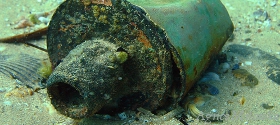Diving the historic PS Clonmel wreck |
 |
| Written by Agnes Milowka | |||
| Tuesday, 18 January 2011 00:00 | |||
|
This describes the experience of those traveling on board the paddle steamer PS Clonmel, as it ran aground on its voyage from Sydney to Port Phillip (now Melbourne) in the early hours of the morning on the 2nd of Jan 1841. The ship and its thirty-eight passengers and forty-two crewmembers were firmly stuck and nothing, not even throwing cargo overboard was going to lighten the ship. There was nothing left to it, the ship had to be abandoned. Captain Tollervey coordinated the effort and by the afternoon transferred all on board and some provisions ashore to a makeshift camp. While everyone was out of immediate danger, this was not the end of their problems; they were stranded and surrounded by wild, rugged and unexplored country, in one of the most remote areas of the young colony. The PS Clonmel was a two masted, schooner rigged paddle steamer and was the first steamer to sail in Australian waters. The ship was one of the last wooden steamships built in England before iron became the dominant material used and as such it represents the peak of wooden shipbuilding technology. The ship was a total wreck and relatively little was salvaged off the vessel over the years, which makes this shipwreck a significant site and worthy of the highest level of protection. The wreck is also historically significant as it acted as a catalyst for the opening up of the Gippsland region to trade and pastoral settlement, as the wreck occurred just off the entrance of a deep harbor that became Port Albert. As such a 50m Protected Zone was declared around the wreck and access to it requires a permit from Heritage Victoria. I was lucky enough to join the Maritime Heritage Unit of Heritage Victoria when they were doing field work on the site. Heritage Victoria staff regularly visit the site in order to monitor the wreck and study the remains of the hull and the machinery. A variety of artifacts including portholes, deck-lights and brass skylight protectors as well as cut glass tableware and a number of pennies have been recovered from the site and now reside in the local museum. There is a wealth of archaeological material left on site to this day however, much of it buried and protected by the sand. The most imposing part of the wreck is its boiler and the base of its funnel that protrudes out of the water at low tide. It’s worth noting that the engine room of the Clonmel was 58ft long and took up more than a third of the ship’s length! The 220 horsepower engine drove the paddlewheels, but it was a guzzler and required 610kg of coal per hour to run. Today this wreck is not only an incredible dive site (it is not often a diver gets an opportunity to dive on a shipwreck where relics can still be found on site) it also gives us a unique insight into the Australian way of life in the 1840s. So what happened to the castaways, did they survive? No one knew they had wrecked and with little hope of salvation they had to take matters into their own hands. One of the passengers, a Mr Simpson was an experienced seaman and volunteered to take one of the whaleboats to the closest settlement in order to raise the alarm and get help. The seven volunteers piled into the frail open boat and set off towards Port Phillip the very next day. It took over sixty hours for the team to get in sight of civilization and they battled fierce wind and waves every step of the way. The little boat was swamped by the breaking seas many times throughout the voyage and required continual bailing to keep afloat. By the time the cutter Sisters picked them up, they were soaked to the skin, cold and exhausted. It was the heroic efforts of these men that saved the remainder of the shipwrecked crew. To read more about the history and the wrecking of the PS Clonmel check out 'Clonmel - Disaster to Discovery' a free publication available from Heritage Victoria.
|
 Imagine being woken by the sudden jolt of the ship as it strikes a sand bank traveling at ten knots per hour. The wooden ship shudders beneath you and then comes to a grinding halt. Imagine the fear, the confusion and the feeling of panic as you stumble out of bed and rush up on deck. Thick mist surrounds the ship but you can clearly see the waves that crush across the shallow sandbank, each one lifting the vessel higher upon the bank.
Imagine being woken by the sudden jolt of the ship as it strikes a sand bank traveling at ten knots per hour. The wooden ship shudders beneath you and then comes to a grinding halt. Imagine the fear, the confusion and the feeling of panic as you stumble out of bed and rush up on deck. Thick mist surrounds the ship but you can clearly see the waves that crush across the shallow sandbank, each one lifting the vessel higher upon the bank.